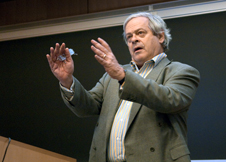The fall and possible rise of a great American city

Detroit in the 1950s was the wealthiest city in the country, said journalist and author Dan Okrent of his hometown. Now the city is broke, with more than 30 percent of its workers unemployed and 40 percent of its people illiterate.
“The people of Detroit are suffering more than anywhere else in the country as a mass of people,” said Okrent, a former editor at Time Magazine and the New York Times. “If Detroit had been fortunate enough to have a flood like Katrina, the country would know what was happening there and would do something about it.”
How did it happen and what can be done now? Okrent, and Theresa Lynch, a senior researcher at the Initiative for a Competitive Inner City, explored those questions recently at Northeastern’s Open Classroom Policy speaker series, sponsored by the School of Public Policy and Urban Affairs.
The beginning of Detroit’s downward spiral, said Okrent, occurred “many, many, many” years ago. In the 1950s, when car ownership became universal and the only three auto companies that mattered were in Detroit, it was a city of high employment and homeownership, of single-family homes on elm-lined streets.
“Everybody thought we were blessed,” he said.
But the city and its leaders were blind to their over-dependency on the auto companies. When the chairman of General Motors said, “What’s good for General Motors is good for the country,” said Okrent, the people of Detroit believed.
“The Big 3 auto companies called the shots and everybody listened to them because they employed everybody,” he said.
What followed was a series of social and political missteps: urban renewal policies replaced neighborhoods with soulless developments or built expressways that served to draw people out of the city; white flight to the suburbs increased, exacerbated by the 1967 riots.
Politicians who believed they were serving the city’s interests instead facilitated its downfall, said Okrent. For example, they fought off stricter federal gas mileage standards in the late 1980s and early 1990s on the assumption that these would benefit only the Japanese car companies. “And what happened is people bought the Japanese cars instead of the Detroit cars and the industry began to crumble,” he said.
To recover from these decades of mistakes and miscalculations, said Okrent and Lynch, a once great city will need to get smaller.
The city can’t afford to provide services to residents living in some of its sparsely populated sections, they said. “This means we’re going to give up on . . . neighborhoods and help [people] move,” said Okrent. “It’s heartless, but now we have an entire city suffering without these services. If you don’t have safety and schools, you don’t have a functioning city, and that’s where Detroit is right now.”
Lynch, who is working on an economic development strategy to restart the city through the Detroit Work Project, said the strategy must focus on growing the job base, particularly in the city’s core.
She said it will be important to determine the skill sets of workers, and which skills are in highest demand. With 20 percent of the workforce lacking college degrees, “You have to create jobs for people without college degrees as well as with college degrees,” she said.
Her group has surveyed Detroit’s industrial land, and found 22 percent to be vacant. “We can start to match parcels with those looking for land,” she said.
“There’s been a lot of talk about bringing industry back [in America], and Detroit would be one of those places where this would work,” she said.
Adds Okrent, “I think Detroit has a chance, but it will take an act of political will that we’ve never seen before.”





